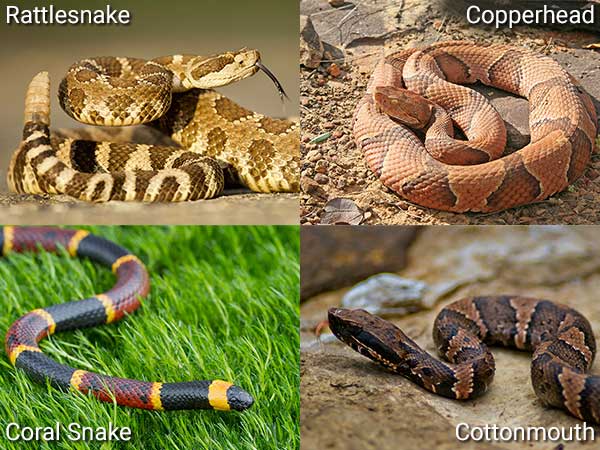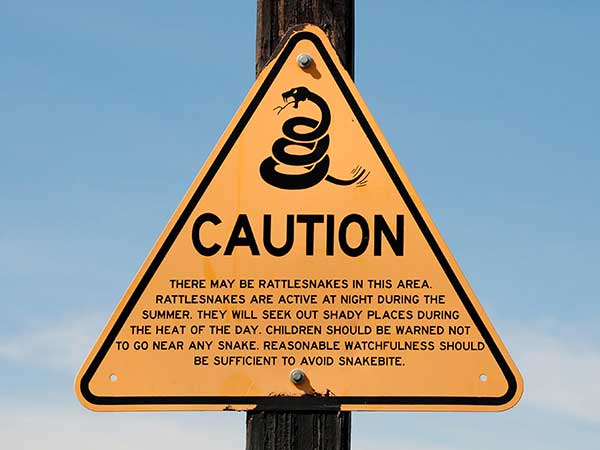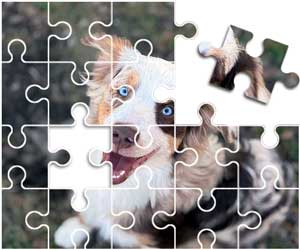
How to Treat a Dog Snake Bite
Adog snake bite can be one of the most serious health emergencies any pet owner can face. No matter how careful you may be, it may still be possible for your dog to encounter a snake and the result of that interaction can be devastating if your dog does not get treatment right away. It's important for all owners to be aware of the potential dangers and know what to do if your dog is bitten.
Since snakes seek shelter in warm, dark places you can take some measures to make your yard safe by removing wood piles and cutting the grass short. For working or herding dogs like Australian Shepherds, though, ensuring their safety can be much harder as they are often in open spaces and underbrush where snakes normally live. For this reason, snake bites on dogs can be a particular problem for these breeds.
The danger from a dog snake bite can vary depending on the type of snake, but it's a good rule of thumb to presume that any snake your dog encounters may be venomous. If you can safely identify the snake that will help but you should never do anything to put yourself in harm's way. If you can safely and without delaying treatment get a photo of the snake for identification purposes, it will be helpful information for your vet. The most important step to take after your dog is bitten is to call your vet so that they can be prepared to provide proper treatment when you arrive.

tomreichner (UL), Nathan (UR), Mark Kostich (LL), Kevin (LR) / stock.adobe.com
Learn which snakes are common to your area and how to identify them. For example, in North America most snake bites on dogs are from Rattlesnakes, Copperheads, Cottonmouths, and Coral Snakes.
Identifying a Dog Snake Bite and Knowing the Symptoms to Watch For
So how can you identify snake bites on dogs? Unfortunately, that can be difficult to do as the actual puncture marks may be very faint and can easily be hidden beneath a dog's fur. It's much more important to be aware of the potential symptoms of a snake bite and to take immediate action if your dog should exhibit them.
Common symptoms of a dog snake bite can include:
- Collapse followed by apparent recovery
(Note: This sounds good but it is not. It may indicate that your dog has received a lethal dose of venom.) - Lethargy
- Muscle tremors, shaking and reduced eye blinking
- Dilated pupils
- Sudden onset of wobbliness/weakness
- Complete paralysis
- Inability to control bladder or bowels
- Irregular bleeding from the nose, bite site or mouth
- Discolored, dark or bloody urine
Get Your Dog to the Vet and Let Them Decide How to Treat a Snakebite
To be prepared for the situation, keep your vet's emergency phone number programmed into your phone. Reaction to snake bites on dogs can vary from one dog to another and symptoms may not become apparent for up to 24 hours after the bite, so it can be difficult to determine if you don't actually witness the bite yourself.
The venom may cause swelling in the upper respiratory system making it hard for the dog to breathe. The venom of Coral Snakes and Rattlesnakes, for example, paralyzes the upper respiratory system. The bites are most dangerous if they occur around the head or near the heart.
One significant symptom that is often overlooked or underestimated is a sudden collapse followed by a seemingly spontaneous recovery. Even if your dog seems to rebound on his own, you should still take him to the vet for treatment because this is a sign that your dog has received a lethal dose of venom.
What to Do if Your Dog Is Bitten by a Snake
If you do suspect a dog snake bite, there are some steps you can take to help.
First and foremost, you should always remain calm. If you start to panic your dog is liable to pick up on that reaction and get excited as well and the increased adrenaline from that kind of response can cause the venom to act quicker. So take a deep breath and try to keep your dog as stress free as possible.
Secondly, you should immediately call your vet. Let him or her know what has happened and that you suspect a snake bite. This will allow the vet to prepare for your arrival and, most importantly, will give the vet time to acquire anti-venom if they don't already have it in stock. Since time is of the essence when dealing with snake bites on dogs, this step is extremely important.
If you can determine the site of the dog snake bite, you should apply a firm bandage above, below and over the bite. This will help to prevent the venom from traveling to the heart. You do NOT want to apply a tourniquet, however, as that can stop the supply of blood to the affected limb, which can cause serious health problems and may even result in the death of the limb. You should also never use suction to remove the venom as this can also cause severe complications, including making you ill as well.
If the bite is on the dog's face or neck, you should remove the dog's collar as the area around the bite may swell. You should also try to keep your dog as still as possible as the more he moves around the more likely it is for the venom to cause complications, since it prevents the blood from clotting. Again, just remember the key point about snake bites on dogs and remain as calm as possible while getting immediate veterinary help.
Snake Bites on Dogs Should Not Be Handled at Home
Because snake venom is poisonous and prevents blood clotting, the two main treatments for dog snake bite are anti-venom and blood transfusion, both of which must be administered by a veterinarian. That means there is really little you can do to treat a bite at home other than the basic care recommendations mentioned above. Getting your dog to the vet as quickly as possible is the most important thing you can do.
Dogs are naturally curious animals, so it is nearly impossible to prevent encounters with snakes when your dog is outside. But whether you are just playing in the backyard or your dog is working a herd in the field, it's important to be aware of the signs and symptoms of a dog snake bite so that you can take action as quickly as possible if anything does happen. If you act appropriately and get your dog to the vet immediately, then the likelihood of his surviving is actually quite good so there is no reason why a snake bite has to be a fatal occurrence.
Have Dog Training Questions?
Check out these introductory dog training videos...
I want my dog to stop being aggressive.
I want some help training my new puppy.
I want my dog to stop barking at everything.
Get Australian Shepherd Info, Website Updates, Special Offers, and Cartoons...
FREE GIFT
You'll also receive a free copy of the ebook
My Everyday Dog Training Tools
by professional dog trainer Daniel Abdelnoor, "Doggy Dan"











